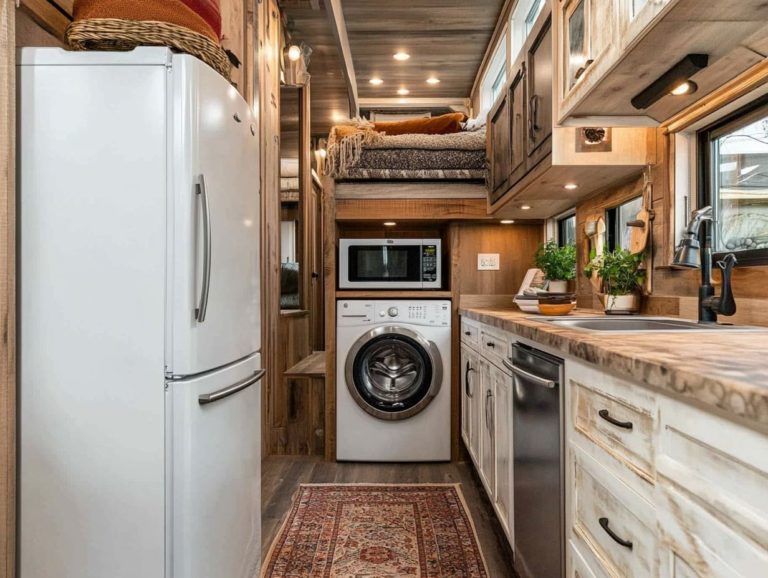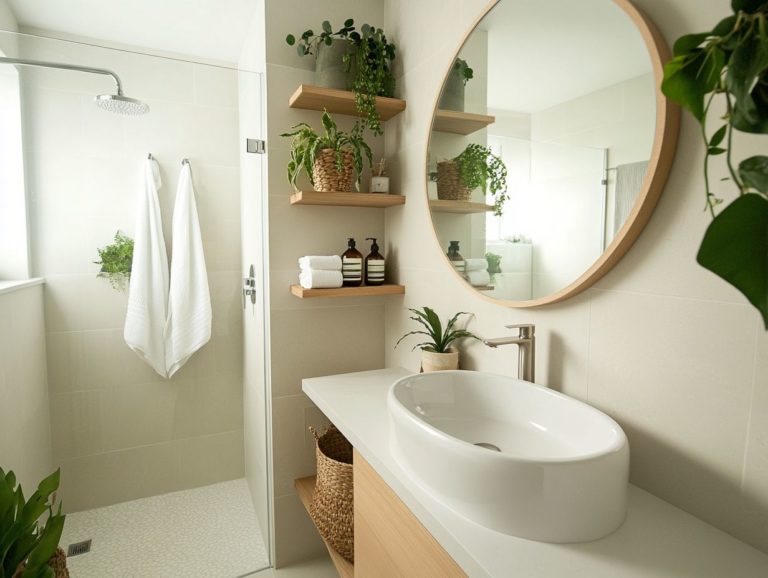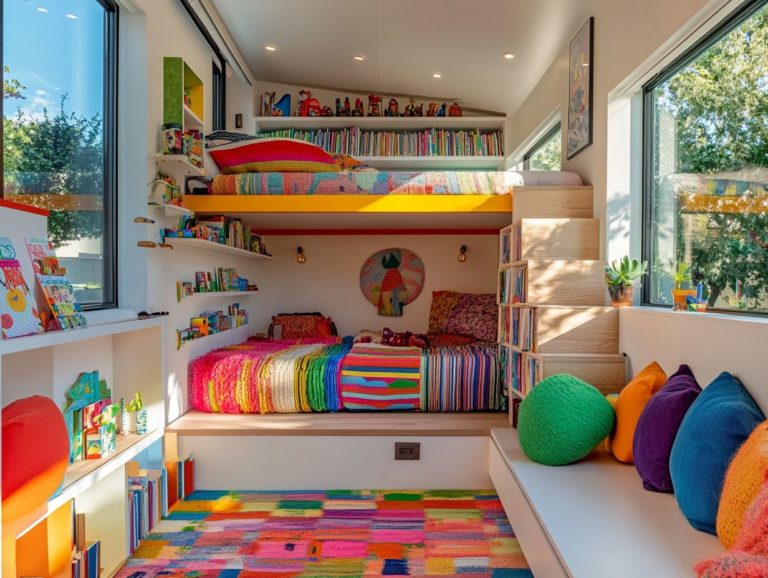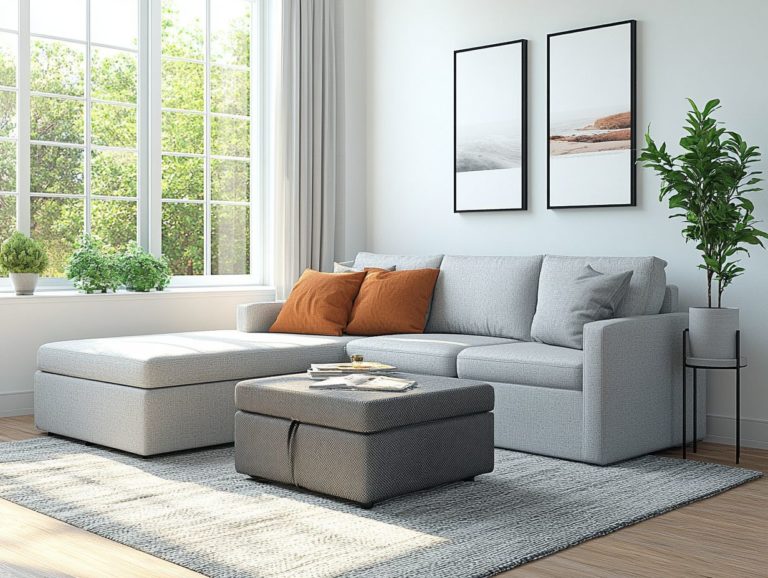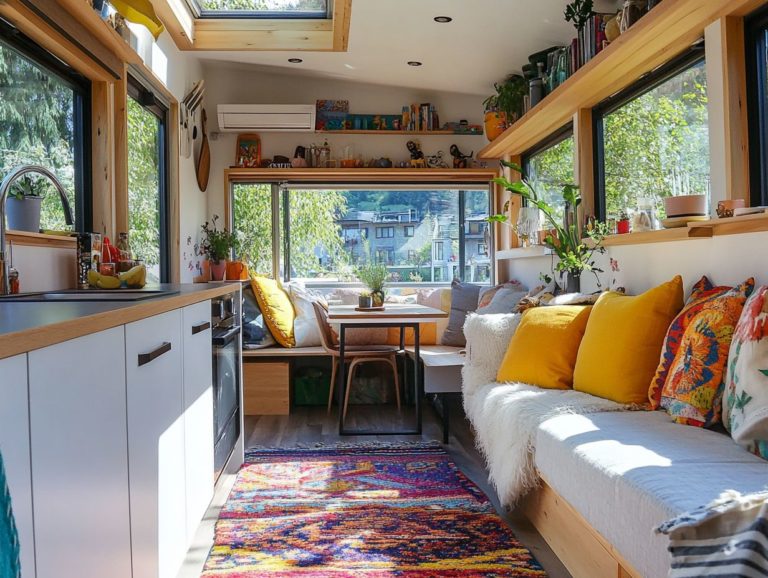5 Best Practices for Tiny House Room Dividers
In the realm of tiny living, every square foot is precious. Room dividers are key to maximizing both functionality and style while creating a cozy atmosphere!
This article delves into five essential practices for selecting and utilizing room dividers in your tiny home, offering creative ideas for maximizing space. You’ll learn how to choose the right type of divider, incorporate multi-functional furniture, and explore unique materials that can elevate your space, enhancing the overall decor.
Uncover how the right dividers can enhance your home s practicality and aesthetics, making your tiny house feel more spacious and inviting while ensuring privacy and openness.
Contents [hide]
- Key Takeaways:
- 1. Consider the Functionality of the Space
- 2. Choose the Right Type of Room Divider
- 3. Utilize Multi-Functional Furniture
- 4. Use Creative and Unique Materials
- 5. Incorporate Natural Light and Openness
- What Are Tiny House Room Dividers and Why Are They Important?
- What Are the Different Types of Room Dividers Available for Tiny Houses?
- Discover the Best Room Dividers for Your Tiny House!
- How Can Room Dividers Maximize Space in a Tiny House?
- What Are Some Creative Ideas for DIY Room Dividers in Tiny Houses?
- How Can Room Dividers Enhance the Aesthetic of a Tiny House?
- Frequently Asked Questions
- What are the 5 best practices for tiny house room dividers?
- How can I maximize vertical space when using room dividers in a tiny house?
- Why is multi-functional furniture important when designing room dividers for a tiny house?
- How does natural light benefit tiny house room dividers?
- What are the advantages of sliding or folding dividers in a tiny house?
- How can I create visual separation with room dividers in a tiny house?
Key Takeaways:
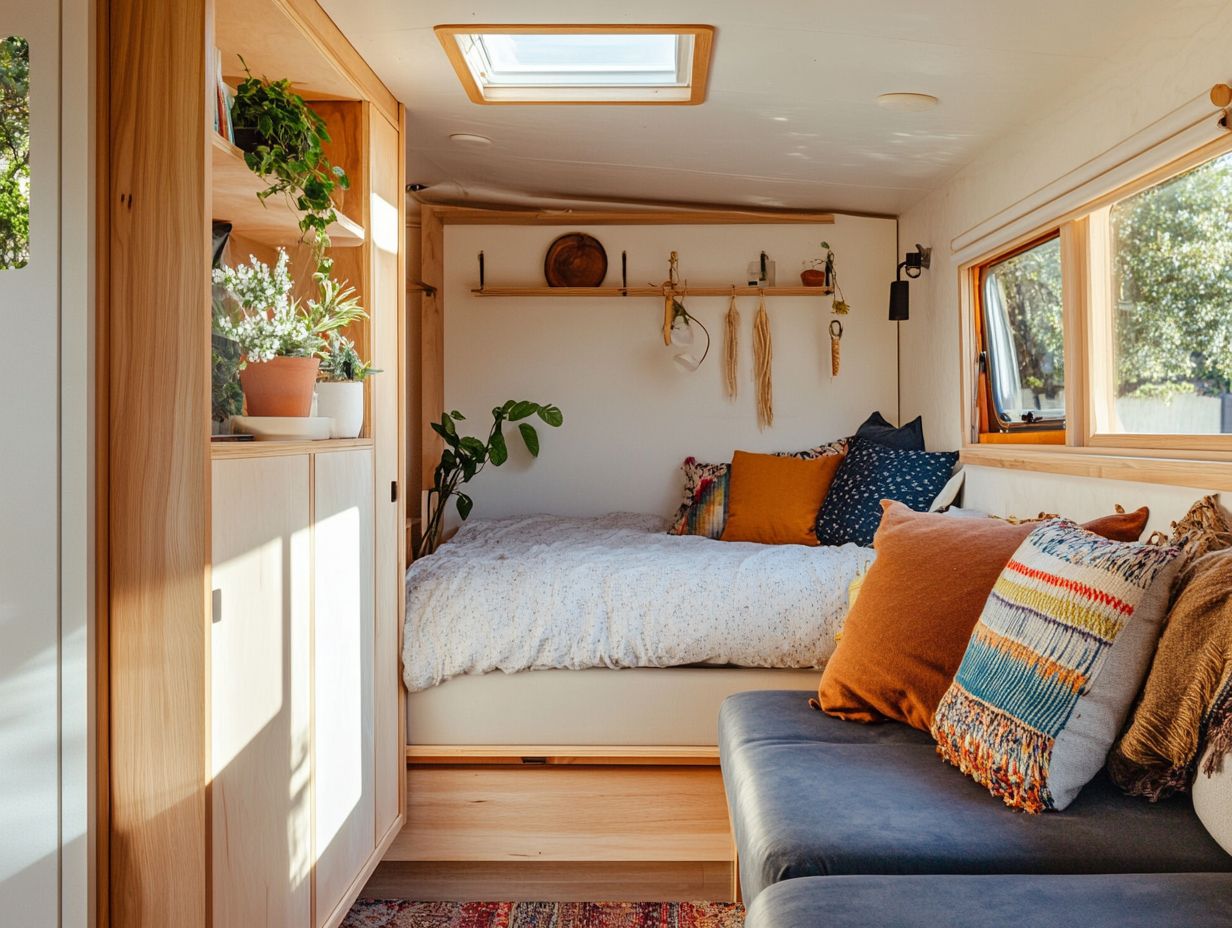
- Consider the functionality of the space before choosing a room divider for a tiny house! It should serve a purpose beyond just dividing the space, creating distinct areas for living and working.
- Choose the right type of room divider for your tiny house, such as curtains, folding screens, or stylish walls, to maximize space and maintain a sense of openness!
- Utilize multi-functional furniture, like a stylish bookshelf or foldable screens, to serve as room dividers while also providing additional storage or functionality in your home!
1. Consider the Functionality of the Space
When you re designing a space, it s crucial to think about its functionality. The right room divider can effortlessly enhance both privacy and openness, catering to your needs whether you re creating a cozy living room or an efficient home office.
This thoughtful approach makes the overall ambiance more inviting and organized. By incorporating elements like decorative screens or flowing curtains, you can easily establish boundaries while still maintaining an airy feel!
These dividers do more than just define spaces; they add a cozy touch, creating quiet corners where you can relax or concentrate. Consider strategically placing furniture, such as bookshelves or open shelving, which can serve dual purposes: providing storage solutions and visual separation.
Don t underestimate the aesthetic appeal of room dividers! They can either make bold design statements or subtly blend in with your existing decor, enhancing the overall theme of your space.
2. Choose the Right Type of Room Divider
Selecting the right type of room divider is essential for crafting the atmosphere and functionality you desire. Whether you choose folding screens, permanent walls, or imaginative DIY options, each should complement your home decor and personal aesthetic!
These dividers can serve a multitude of purposes. From creating a cozy reading nook to defining distinct areas in an open-concept layout, folding screens provide the flexibility to be easily moved or stored when they re not in use.
Curtains offer a softer touch that can be drawn back to open up the space. Bookcases not only separate areas but also introduce storage and style, allowing you to showcase your favorite books and decorative treasures!
On the flip side, permanent walls deliver durability and can significantly improve sound insulation. Consider how each option impacts your overall design you ll find the perfect divider that fits beautifully with your furniture!
3. Utilize Multi-Functional Furniture
Incorporating multi-functional furniture into your design maximizes space and enhances the functionality of your room. This offers inventive solutions for seating, storage, and room division all while preserving a cozy atmosphere.
These versatile pieces play crucial roles in modern living, transforming how you use your spaces. Take, for instance, a sofa that effortlessly converts into a bed; it provides extra sleeping space for guests while doubling as a chic centerpiece in your living room.
Bookshelves that serve as room dividers not only help define work areas in your home office but also display your personal collections, adding a touch of aesthetic appeal! By thoughtfully integrating these elements, you can create organizational harmony while elevating your overall decor, making each room feel more inviting and purposeful.
4. Use Creative and Unique Materials
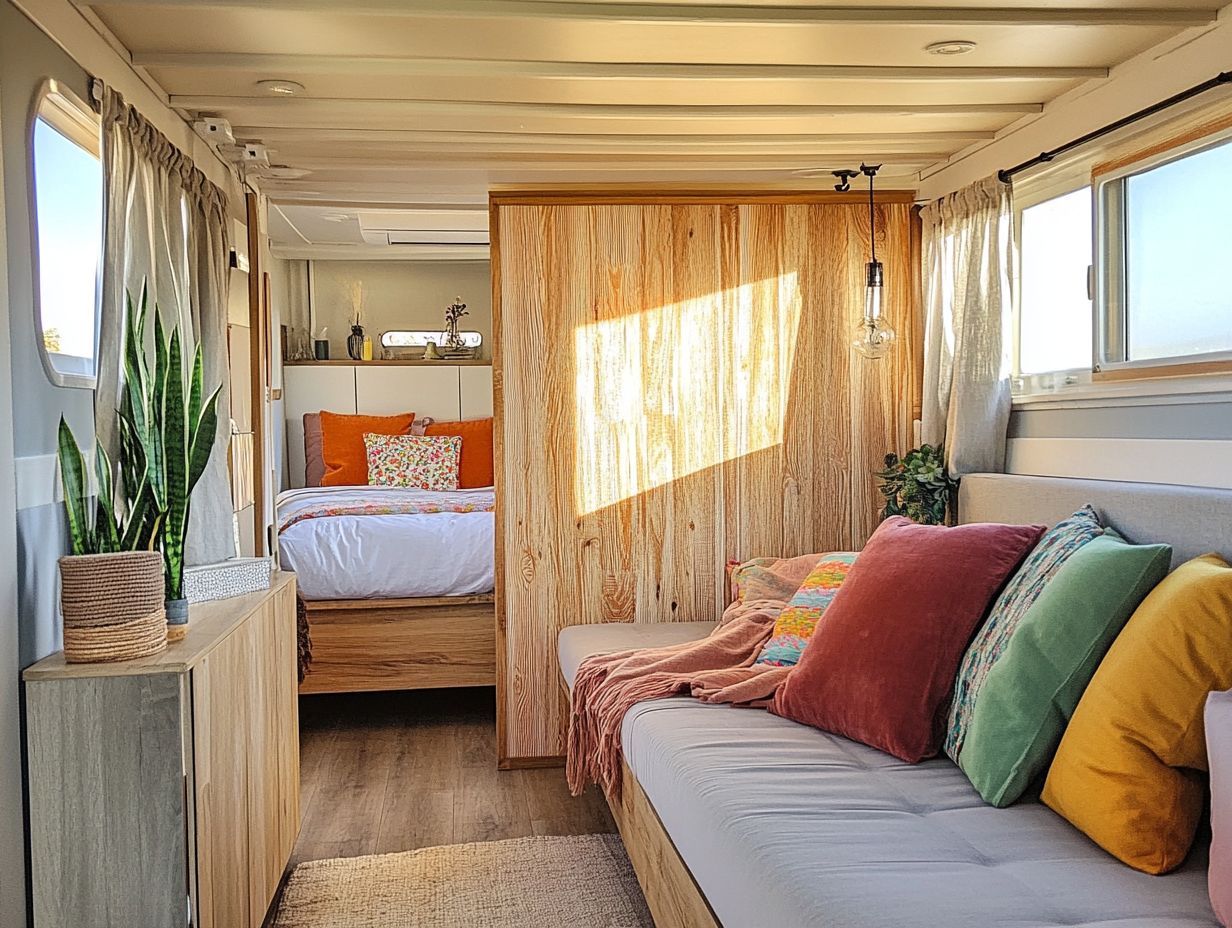
Using creative and unique materials for your room divider can elevate the texture and aesthetic appeal of your space. It transforms the divider from a functional element into a standout piece that showcases your personal style.
Consider incorporating reclaimed wood. It infuses warmth and rustic charm, making your room feel more inviting. Alternatively, fabric dividers add softness, absorb noise, and create a cozy ambiance. If you prefer an industrial vibe, metal dividers offer a sleek, modern edge while ensuring durability. For those exploring tiny house designs, check out 5 ways to enhance privacy in your space.
Engaging in do-it-yourself (DIY) projects allows you to customize these materials, adding personal touches that reflect your unique taste. Thrift stores and craft shops often provide budget-friendly options that inspire experimentation. This guarantees that your final result not only separates spaces but also enhances your room’s overall character.
5. Incorporate Natural Light and Openness
Incorporating natural light and maintaining openness in your design is essential for creating a bright and inviting atmosphere. Strategically placing room dividers allows light to flow freely while providing necessary separation and privacy.
Opt for transparent or semi-transparent dividers, like glass or lightweight materials. They encourage light to penetrate deeper into your space and preserve a sense of connectivity between different areas. This technique lets you blend functions seamlessly, ensuring that zones are defined yet visually accessible.
Embracing an open design philosophy promotes better airflow and alleviates feelings of confinement. This makes your environment feel larger and more welcoming. Thoughtful furniture arrangement and minimizing bulk enhance the ambiance and usability of any room, creating an effortless flow that feels inviting and spacious.
What Are Tiny House Room Dividers and Why Are They Important?
Tiny house room dividers are vital for maximizing your limited space. They offer privacy and functionality while allowing for creative designs that enhance the overall decor of your compact living environment.
These dividers beautifully define spaces for sleeping, working, or relaxing, cultivating a sense of separation in cozy living areas. For example, sliding panels or open shelves can segment rooms without completely enclosing them, preserving that essential airy feel crucial in smaller spaces. You might also explore 7 creative ways to partition tiny spaces for more innovative solutions.
They also present enchanting decor opportunities with diverse materials and styles, adding unique personality to every nook. By achieving the perfect balance between openness and privacy, these room dividers empower you to shape your ideal living experience, harmonizing coziness and functionality effortlessly.
What Are the Different Types of Room Dividers Available for Tiny Houses?
Various room dividers are perfect for tiny houses, including screens, folding partitions, curtains, and DIY bookcases. Each provides unique solutions to maximize your space and enhance privacy.
These options allow you to create functional zones without permanently altering your layout, providing design flexibility. Screens can add an artistic touch while maintaining a light atmosphere. Folding partitions are versatile; you can easily set them aside when not in use, making them ideal for multifunctional areas. Curains offer a soft barrier that can be drawn open or closed, allowing for adaptable living. For those living in compact spaces, consider these 5 tips for designing tiny house bedrooms. DIY bookcases not only act as dividers but also offer additional storage common in smaller homes while adding unique character.
While these dividers enhance functionality, consider factors like sound insulation and natural light flow to ensure your living environment remains harmonious.
Ready to transform your space? Dive into our tips on choosing the perfect room divider!
Discover the Best Room Dividers for Your Tiny House!
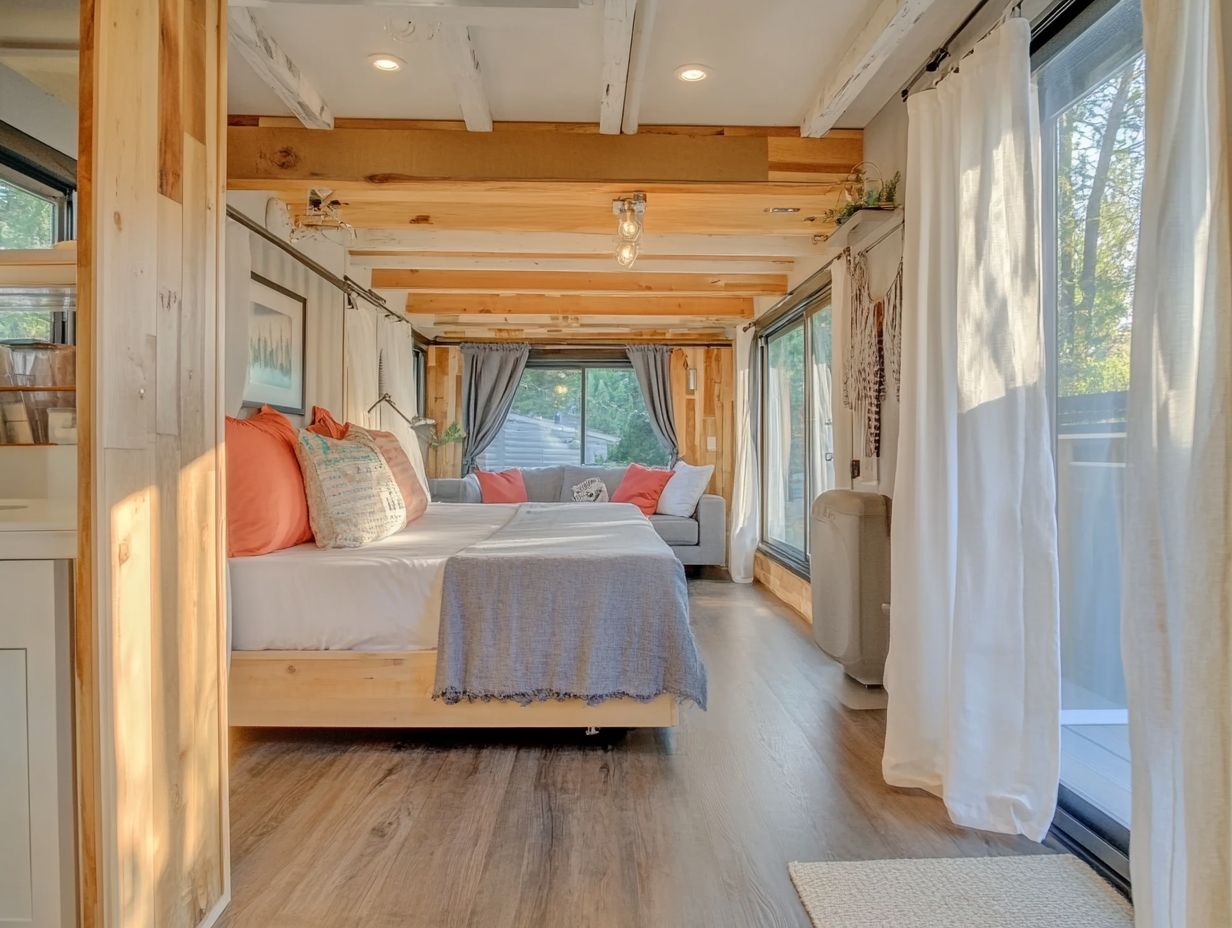
Each type of room divider has unique advantages and drawbacks. It’s essential to evaluate options like screens, folding dividers, and fixed walls that don’t move, providing a strong barrier, to find the one that best meets the needs of your tiny house.
In compact spaces, where every square inch is precious, it’s crucial to balance functionality with design. For example, folding dividers offer remarkable flexibility; they can be easily moved or stored away when not in use. Additionally, learning how to use space dividers in tiny homes can enhance your living area. Fixed walls provide a sturdy solution but can significantly alter the flow and openness of a room, affecting the overall look.
Cost is another key consideration when selecting room dividers for your tiny space. If you’re budget-conscious, lightweight screens might be your best bet! They offer necessary separation while also looking good. It’s vital to consider how each option complements your decor, ensuring that the chosen divider serves its purpose while enhancing the overall vibe of your home. For more inspiration, check out these 5 tips for cozy tiny house living rooms.
How Can Room Dividers Maximize Space in a Tiny House?
Room dividers are essential for maximizing space in your tiny house. They provide functional separation without compromising flow and also create opportunities for creative decor!
By incorporating these versatile elements, you can craft unique zones tailored to your various activities, whether it’s working, sleeping, or unwinding. For instance, a stylish folding screen can elegantly separate a cozy bedroom nook from a dedicated home office, allowing for focused productivity while maintaining an airy atmosphere. Additionally, consider these 5 tips for decorating your tiny home to maximize your space effectively.
Shelving units can double as both storage and a divider, showcasing books and indoor plants that bring life into the space. These innovative arrangements help you enjoy distinct atmospheres, ensuring you make the most of every square foot while facilitating a harmonious flow throughout your home!
What Are Some Creative Ideas for DIY Room Dividers in Tiny Houses?
Creating DIY room dividers can be an enjoyable and budget-friendly endeavor. It allows you to infuse your personal touch into the space using unique materials and designs that are both functional and visually appealing.
Whether you choose reclaimed wood for rustic charm or vibrant fabrics for a splash of color, these projects allow you to showcase your style while maximizing limited square footage. Incorporating greenery, like potted plants, improves air quality and introduces a refreshing touch of nature, fostering a serene atmosphere.
Each of these ideas can be tailored to fit various decor styles, from modern minimalism to bohemian aesthetics. This way, every divider not only serves the practical purpose of defining spaces but also stands out as a statement piece. For more tips, check out these smart strategies for tiny house organization.
How Can Room Dividers Enhance the Aesthetic of a Tiny House?
Room dividers can truly elevate the aesthetic of your tiny house! They introduce design elements that beautifully complement your decor style, whether through screens or curtains, while creating visually distinct areas.
These stylish barriers define spaces for sleeping, working, or living, all while infusing an artistic flair into your rooms. Modern screens lend a sleek, contemporary vibe, while rustic wood partitions bring a warm, natural feel that invites coziness. Elegant curtains offer flexibility and softness, allowing you to adjust your environment easily based on your mood! Additionally, to maximize your tiny space, consider these 5 essential tips for efficient tiny house layouts.
This unique blend of functionality and design empowers you to express your creativity, transforming compact spaces into functional masterpieces that reflect your personal style without compromising comfort.
Frequently Asked Questions
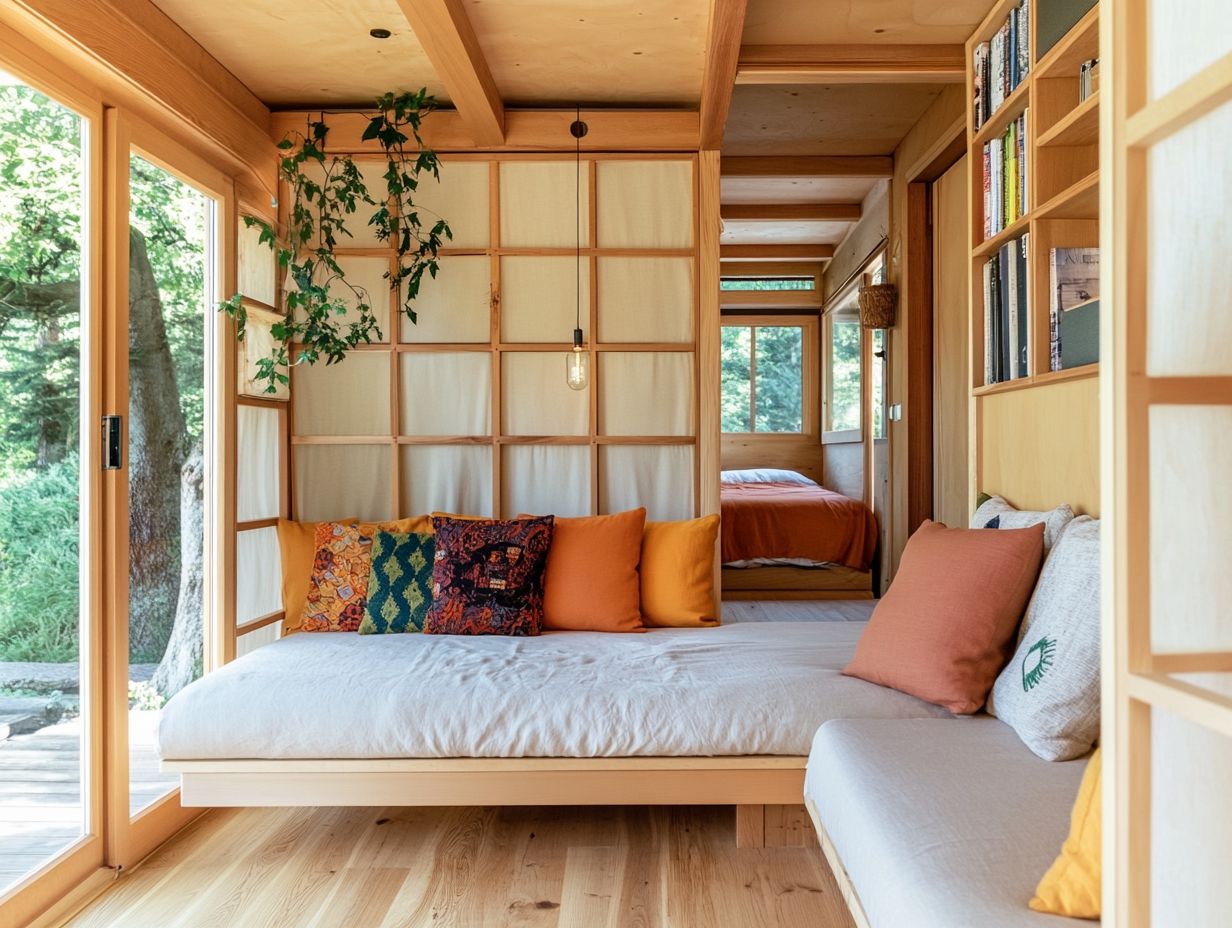
What are the 5 best practices for tiny house room dividers?
Here are five best practices: maximize vertical space, use multi-functional furniture, incorporate natural light, utilize sliding or folding dividers, and create visual separation for privacy.
How can I maximize vertical space when using room dividers in a tiny house?
You can use tall bookshelves or storage units as dividers. Install floating shelves or hang curtains from the ceiling to add height and texture.
Why is multi-functional furniture important when designing room dividers for a tiny house?
Multi-functional furniture saves space and reduces clutter. For example, a bookcase can be both a room divider and storage solution.
How does natural light benefit tiny house room dividers?
Natural light makes a small space feel larger and more open. Using translucent materials like glass or sheer curtains allows light to flow through and brightens the ambiance.
What are the advantages of sliding or folding dividers in a tiny house?
Sliding or folding dividers save floor space when open. They also offer flexibility, easily allowing you to open or close off a room as needed.
How can I create visual separation with room dividers in a tiny house?
Use different materials, colors, or textures to achieve visual separation. For instance, a wooden bookshelf can contrast with wall colors, enhancing the space’s aesthetic.

